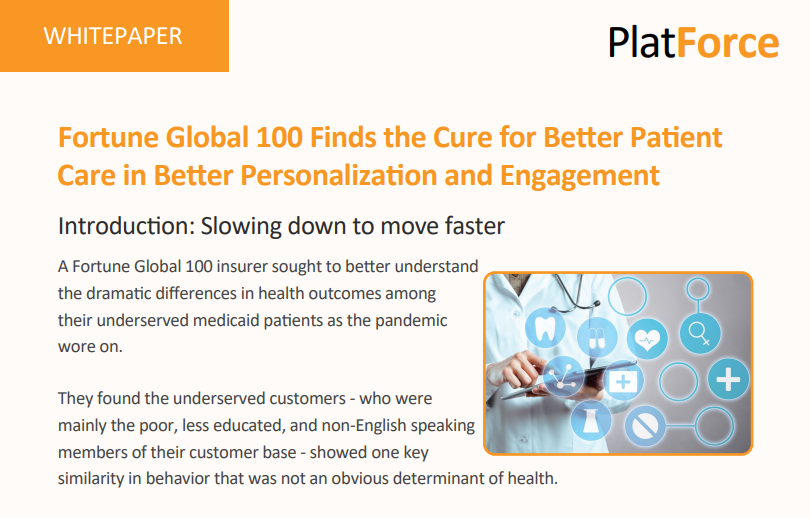Case Study: Boost Personalization and Engagement
See how you can boost your personalization and engagement efforts in our case study: Building digital literacy to help you launch new new digital business services.
Introduction: Slowing down to move faster
A Fortune Global 100 insurer sought to better understand the dramatic differences in health outcomes among their underserved medicaid patients as the pandemic wore on.
They found the underserved customers – who were mainly the poor, less educated, and non-English speaking members of their customer base – showed one key similarity in behavior that was not an obvious determinant of health.
In looking to improve this they realized they needed to back up and examine their approaches to communicating with their customers with their digital programs. They simply could not treat all customers the same digitally and assume similar digital confidence and competence.
PlatForce, a leading business building platform that typically helps organizations power commercial growth and innovation with monetization and insights, is helping in this innovative use case to power trust and healthcare adoption via engagement and personalization for these underserved communities.
Digital Literacy Explained
Digital literacy is the ability to effectively use and interact with technology, including computers, smartphones, and the internet. Despite the increasing ubiquity of these technologies, there remain several challenges to digital literacy in the US:
Access
While access to technology and high-speed internet has improved across the country over the years, there are still areas, particularly in rural and low-income communities, that lack adequate access and/or the means to afford digital services.
This “digital divide” can hinder individuals from developing digital literacy skills.
Training
Despite government, community, and service provider efforts to provide internet services, schools and educational institutions may not always have the resources, infrastructure, or funding to provide comprehensive digital literacy training.
Additionally, teachers and community members may not be adequately trained in digital literacy themselves, making it difficult for them to effectively teach students.
Additional Factors
Lastly, generational differences, language, and cultural differences also pose challenges in driving motivation to learn and use digital services effectively.
Addressing these challenges requires a multi-faceted approach that includes increasing access to technology and the internet, providing affordable solutions, enhancing education and training programs, and promoting awareness of the importance of digital literacy.
You Simply Can’t Treat Your Customers the Same Digitally
Understanding digital confidence and competence
While the digital world offers numerous opportunities and benefits, it is essential to recognize that not everyone has the same level of digital confidence and competence.
Assuming that everyone is digitally proficient can lead to several dangers and unintended consequences namely inequality by inadvertently excluding customers who lack digital skills or access, thus marginalizing them and hampering positive health outcomes.
Among those who may struggle to understand or use digital platforms and tools effectively may negatively impact trust, engagement and collaboration.
To address these dangers, it is important to recognize the diversity of digital skills and experiences and to ensure that organizations and service providers take steps to accommodate and support individuals at varying levels of digital literacy.
In the case of the health insurer, this included providing tailored training, offering multiple communication channels, and designing user-friendly interfaces that are accessible to all.
Approaches to Overcoming Digital Divide
Overcoming the digital divide for the poor, uneducated, and non-English speaking populations in the USA requires a multi-faceted approach that addresses the various barriers to digital access and literacy. Many effective strategies exist and we examine them at a few levels including:
Community-based Approaches
Promoting awareness of the digital divide and its impact on individuals and communities. Highlight the importance of digital literacy and the benefits of digital inclusion through public campaigns, educational materials, and targeted outreach efforts.
Encouraging collaboration between various stakeholders, including government agencies, educational institutions, businesses, and community organizations, to develop comprehensive and coordinated strategies for addressing the digital divide.
Investing in infrastructure projects to provide affordable, high-speed internet access to underserved communities, including rural and low-income areas. This may involve supporting community broadband initiatives, public-private partnerships, and funding for network expansion.
Establishing and maintaining public access points, such as libraries, community centers, and schools, where individuals can access computers and the internet for free or at a minimal cost. These facilities can also serve as hubs for digital literacy training and support.
Promoting inclusivity by designing digital platforms, tools, and resources that accommodate non-English speakers by offering multilingual support and culturally relevant content. This may include translation services, language-specific resources, and user interfaces that are intuitive and easy to understand.
Developing and implementing digital literacy programs in schools, adult education centers, and community organizations to ensure that individuals have the skills needed to navigate the digital world effectively. These programs should be tailored to different age groups, skill levels, and linguistic backgrounds.
Individual-level approaches
Affordable devices and services: Encourage the development and distribution of low-cost devices, such as computers and smartphones, as well as affordable internet plans to make digital access more feasible for low-income individuals and families.
By implementing these approaches, it is possible to make significant progress in bridging the digital divide and ensuring that all individuals, regardless of their socioeconomic, educational, or linguistic backgrounds, have the opportunity to participate fully in the digital world.
The Solution – A Step by Step Approach from Community to Individual to App
Translating Triage to Tactics
The insurer netted out the solution into two areas – customer-specific steps and task-specific steps.
This began with an assessment of their customer base for their digital competency and literacy so they could triage customers into:
- Basic users – Those with basic to no digital skills and/or equipment – phones, computers, and internet.
- Job-level Users – Those with competence with digital equipment and applications.
- Super Users – Those highly-proficient users in knowledge-based, technology, or education fields.
A simple tactical implementation of this triage was to test whether customers have a phone, can use it, and can put data into it.
A Phased, Ladder-based Approach
The tactical implementation applied email outreach to Super-user and Job-level users, with follow up phone calls to non responders.
Understanding what languages they need to offer also fostered significant increases in engagement.
And building trust – personalizing digital literacy beforehand helped the insurer interact with customers appropriately , which then helped get engagement on healthcare offerings.
Summary
All applications are increasingly subject to regulation with new privacy and other standards. For all developers, the burden of compliance can be crushing. The volume of simple reporting requirements is huge, and it all needs to be verifiable with secure, high-quality data.
In conclusion, the partnership between this Fortune Global 100 insurer and PlatForce for identifying and validating digital competence and confidence.
The PlatForce platform is providing patients with a fun and engaging way to learn about their health and take an active role in their own care, leading to improved health outcomes and increased patient satisfaction.
Next Steps
Request A Demo to Boost Your Brand, Your Premium Segment Revenues, and Unlock New Digital Service Opportunities.
About PlatForce
PlatForce is a leading business building platform that helps organizations power growth with monetization and insights. Rapidly identify and validate demand with engagement, automation, and insights to help predict new sales channels, segment premium audiences, and monetize new digital business services. The company is headquartered in Miami with offices in Oslo, New York, and San Francisco.



